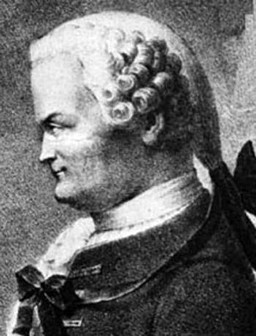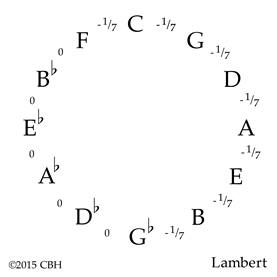Technical Library
TEMPERAMENTS XXIX: Lambert
Entire Contents Copyright © 2015 CBHTechnical LibraryTEMPERAMENTS XXIX: Lambert Entire Contents Copyright © 2015 CBH |
 WIKIMEDIA COMMONS / PUBLIC DOMAIN |
| Jean-Henri Lambert (1728–1777) |
Jean-Henri Lambert (1728–1777) was another broad-minded polymath of the Enlightenment, his output including writings on mathematics, physics, astronomy, philosophy—and some even on music which could interest us. (This is not the Monsieur De Saint Lambert of Les Principes du clavecin fame.) Our Lambert was Swiss, so I’m preferring to call him Jean-Henri rather than Johann Heinrich: His obviously French Remarques sur le tempérament en musique was published in Berlin in 1774, “par Mr. Lambert”. You can view the original document here.
Lambert is a very useful temperament which divides the comma into seven parts. I’ve been tuning it for years, having first come across it as tuner/technician at two of Malcolm Bilson’s fortepiano summer schools at Cornell in the 1980s: Malcolm named his permutation Bilson III, happily noting that he doesn’t “really have two others; but you can’t have a temperament without a number; it’s too low class!” My San Francisco friend and colleague Kevin Fryer calls his stock temperament Fryermeister. After some experimentation, Erin Helyard chose Lambert for Pinchgut Opera’s 2015 production of Grétry’s L’Amant jaloux.
If you can tune Vallotti or Young, you won’t have any problems here.
We’ll again very usefully size a particular Major third, then divide that interval to determine the size of the intermediate slightly narrow fifths around the circle. Proceed as follows:
1. Tune a' to your pitch source, and tune a in absolute perfect tune an octave below it.
2. Find f a third below that a: Tune the interval pure first of all, but then widen it by flattening the f until you hear four distinct beats per second.
3. Like Vallotti, tune all the fifths from the flat side of F around the circle of keys absolutely pure, but stop at G♭ (F♯).
 4. Now we’ll begin to divide the f–a third. Tune middle c' a pure fifth above your f,
and then lower it, squeezing the interval a little until it beats exactly once per second. That fifth is now a seventh-comma narrow, and can serve as a guide for each of your other six narrow fifths.
4. Now we’ll begin to divide the f–a third. Tune middle c' a pure fifth above your f,
and then lower it, squeezing the interval a little until it beats exactly once per second. That fifth is now a seventh-comma narrow, and can serve as a guide for each of your other six narrow fifths.
5. Considering that the same theoretically-sized intervals must beat at increasing speed as you ascend the keyboard, you can now find your other fifths around the circle between C and A. As these seventh-comma fifths are ever so slightly wider than the sixth-comma fifths of Vallotti or Young, they must therefore beat slightly slower. Tune your d' from a' so it beats slightly less than twice per second, a fraction slower than your familiar Vallotti. Drop down from d' to find g: Your g–d' fifth must beat ever so slightly faster than f–c' as it is a tone higher, and will enable you to place e' above a accordingly. Always tune each fifth pure first of all, then squeeze the interval to ensure it is narrow rather than wide.
6. Only one note remains to be found, and you are done: Tune down an octave from e' to e, and jam your b in between the e and the f♯', with both fifths narrow.
7. As a final check, try all your tempered fifths and confirm that each one seems to beat just a little more than the previous as you ascend the keyboard from e–b, f–c', g–d', a–e', b–f♯', c'–g' & d'–a'. All the other intermediate ones are pure: f♯–c♯', a♭–e♭', etc.
If you want something getting closer to Equal Temperament, there is no reason why we can’t go a step beyond Lambert and devize a temperament with eight narrow fifths.
Further discussion
Anonymous [Kayano, Moxzan] Dodecagon — Chi-s akt temo Tokyo 2012, p99
| Pitch nomenclature | |
| Harpsichord Tuning Process | |
| Tuning Bibliography | |
| Technical Library overview | |
| Harpsichords Australia Home Page |